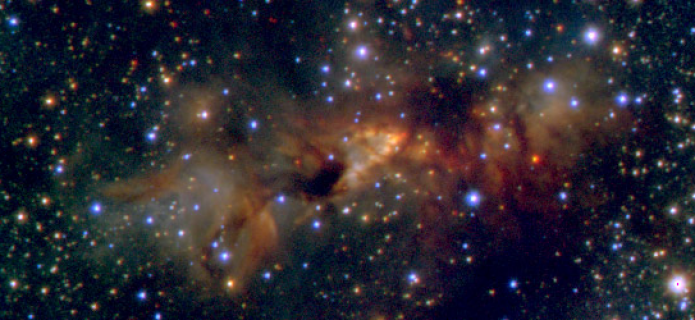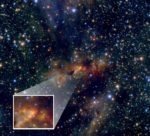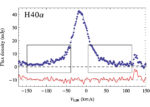Chilean astronomers using ALMA discover new clues about massive star formation
Astronomers using the ALMA radio telescope detected that the supersonic jet and the accretion disk survives the ultraviolet radiation generated by the birth of a massive star. This discovery refutes existing theories, indicating that ultraviolet radiation from the star would destroy molecular gas and dust, and bringing the first direct detection of ionized gas wind along with a supersonic jet and an accretion disk. The research results were published in The Astrophysical Journal.
Massive stars emit a large amount of ultraviolet radiation that destroys the molecules and dust surrounding the star and creates ionized gas, which in turn impedes the star's growth process. This is why previous theories have suggested that the model of a small star forming from a protoplanetary gas and dust disk isn’t applicable to high mass stars. According to the study published today, dust and molecular gas can survive the destructive effects of ultraviolet radiation that accompanies the birth of a massive star.
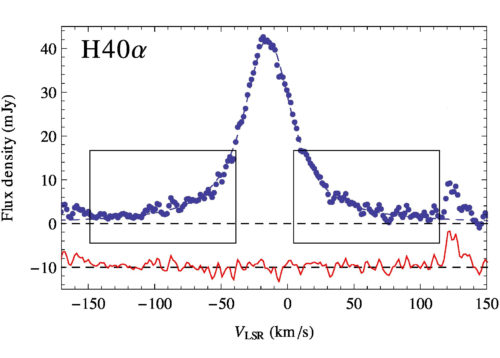
Fig. 1: Spectrum showing the line of hydrogen recombination observed with ALMA looking toward the massive protostar G345.4938+01.4677. The shape of the spectral line in the area indicated by the rectangles is consistent with the theory of broadening in the presence of electric fields known as the Stark effect, detected for the first time so clearly in this observation. The blue dotted line shows the theoretical prediction of the Stark effect.
The young star that was studied, G345.4938+01.4677, is located in the Scorpius constellation and has a mass 15 times greater than the Sun. This is where scientists made at least three important discoveries. "The first thing we detected is a supersonic stream emerging from the star forming inside the ionized gas region. This suggests that the accretion disk and gas stream are strong enough to survive despite the damage caused by ultraviolet light,"explained Andrés Guzmán, the study’s principal researcher and a postdoctoral fellow at the University of Chile.
ALMA's cutting-edge technology enable astronomers to get, for the first time, evidence of the effect of electric fields on the emission of lines of hydrogen. "The detection of this so called Stark effect was possible due to the high density of gas around this star and ALMA's extraordinary sensitivity," said Guido Garay, Director of the Astronomy Department at the University of Chile and a co-author of the study.
"Thanks to the sensitivity and high angular resolution of ALMA we could for the first time detect a rotating disk around a massive star and effects of electric fields on the hydrogen line emission from a jet from the same star", added Lars Nyman, Head of Science Operations at the JAO ALMA Observatory and co-author of the study.
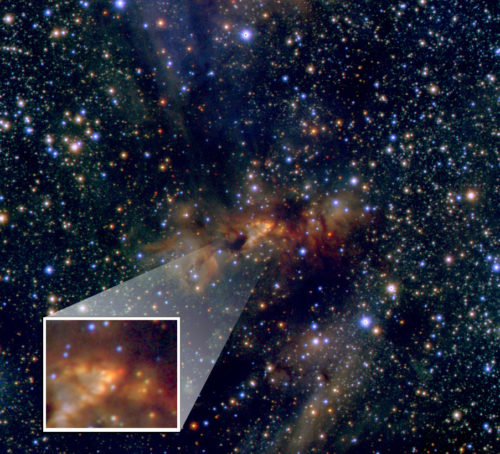
Fig. 2: Image in the infrared spectrum near G345.4938+01.4677 obtained by the VVV project using the VISTA telescope at Cerro Paranal Observatory. In the lower left corner is a close-up of the central area, showing the cavity created by the jet stream. In the center of the image the young high mass star appears as a small and weak red spot.
The third major milestone is the discovery of molecular gas and dust rotating around the massive star. This discovery extends the observation of protoplanetary disks to the high mass regime, where the dynamic is dominated by the mass of the disk rather than the mass of the central star. Even though it was estimated that there are 56 solar masses in the disk, compared to 15 solar masses in the central star, the disk's rotation is perfectly aligned with the stream of ionized gas, suggesting that the supersonic gas stream is being accelerated and aligned from an accretion disk.
In the near future, "we expect to find and study more streams associated with these kinds of hyper-compact ionized regions. Without ALMA it would have been impossible to better characterize the accretion in this massive star and determine whether it is part of a binary system," Guzmán concluded.
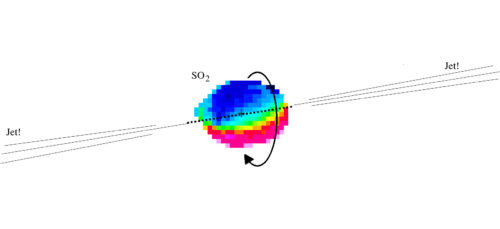
Fig. 3: The coloured area is where ALMA detected emission of sulfur dioxide molecules toward G345.4938+01.4677. The colours indicate the velocity of the gas: blue shows it coming closer, while red shows it moving away. The colour distribution observed is characteristic of material rotating in protoplanetary disks around the protostar. The curved arrow shows the direction of the rotation, indicating that the stream material is ejected through the poles of the disk.
More Information
Twenty-five ALMA antennas were used to make this discovery in 2013.
The scientists who conducted the study include University of Chile astronomers Andrés Guzmán (principal researcher), Guido Garay (Astronomy Department Director), Leonardo Bronfman, and Diego Mardones, as well as Luis Rodríguez (UNAM Center for Radio Astronomy and Astrophysics), James M. Moran (Harvard-Smithsonian Center for Astrophysics), Kate Brooks (Center for Astronomy and Space Science, CSIRO-Australia) and Lars-Ake Nyman (Joint ALMA Observatory).
The Atacama Large Millimeter/submillimeter Array (ALMA), an international astronomy facility, is a partnership of the European Organisation for Astronomical Research in the Southern Hemisphere (ESO), the U.S. National Science Foundation (NSF) and the National Institutes of Natural Sciences (NINS) of Japan in cooperation with the Republic of Chile. ALMA is funded by ESO on behalf of its Member States, by NSF in cooperation with the National Research Council of Canada (NRC) and the Ministry of Science and Technology (MOST) in Taiwan and by NINS in cooperation with the Academia Sinica (AS) in Taiwan and the Korea Astronomy and Space Science Institute (KASI).
ALMA construction and operations are led by ESO on behalf of its Member States; by the National Radio Astronomy Observatory (NRAO), managed by Associated Universities, Inc. (AUI), on behalf of North America; and by the National Astronomical Observatory of Japan (NAOJ) on behalf of East Asia. The Joint ALMA Observatory (JAO) provides the unified leadership and management of the construction, commissioning and operation of ALMA.
Link to article in The Astrophysical Journal
Contact:
Valeria Foncea
Education and Public Outreach Officer
Joint ALMA Observatory
Santiago, Chile
Tel: +56 2 467 6258
Cell: +56 9 75871963
Email: [email protected]
Richard Hook
Public Information Officer, ESO
Garching bei München, Germany
Tel: +49 89 3200 6655
Cell: +49 151 1537 3591
Email: [email protected]
Charles E. Blue
Public Information Officer
National Radio Astronomy Observatory
Charlottesville, Virginia, USA
Tel: +1 434 296 0314
Cell: +1 434.242.9559
E-mail: [email protected]
Masaaki Hiramatsu
Education and Public Outreach Officer, NAOJ Chile
Observatory Tokyo, Japan
Tel: +81 422 34 3630
E-mail: [email protected]
